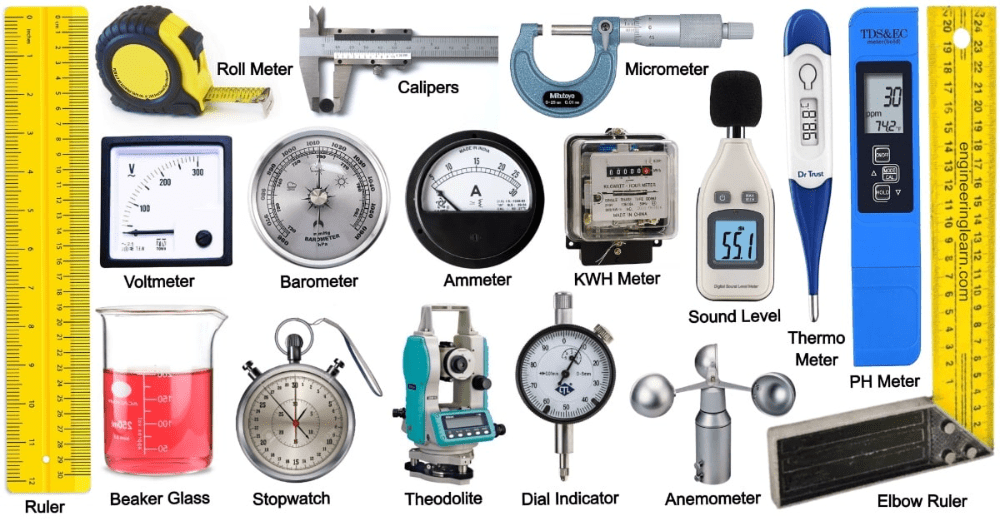It is a device used to get the dimension of a part. Introduction to measuring instruments involves understanding their crucial role in quantifying physical quantities such as length, temperature, pressure, and more. From traditional tools like rulers and thermometers to advanced devices such as oscilloscopes and spectrophotometers, these instruments ensure accuracy in scientific, industrial, and everyday applications, facilitating precise data collection and analysis.

CLASSIFIED
Measuring instruments are classified based on their intended application and the physical quantity they measure. Categories include dimensional metrology for length and size, thermal instruments for temperature, pressure gauges for fluid pressure, and analytical instruments for chemical composition. Each class serves specific purposes in scientific, industrial, and commercial sectors.
These are classified according to use
- LINEAR MEASURING
- ANGULAR MEASURING
- GEOMETRICAL MEASURING
- SURFACE FINISH MEASURING
LINEAR MEASURING INSTRUMENT
This instrument is used for liner measurement. Measurement of length, diameter, height, thickness etc. Linear measuring instruments are essential tools for accurately determining lengths and distances in various applications. Examples include rulers, calipers, micrometers, and laser distance meters. Micrometers excel in measuring thickness and diameters with high accuracy. Laser distance meters use laser technology to measure distances quickly and over longer ranges. These instruments ensure precise dimensional control in manufacturing, construction, engineering, and scientific research. Calibration and regular maintenance are crucial to maintain accuracy.

ANGULAR MEASURING INSTRUMENT
This instrument is used for angular measurement. Measurement angles in degrees, minutes, radians. Angular measuring instruments are crucial for determining angles accurately in various fields like engineering, astronomy, and construction. Examples include protractors, angle gauges, clinometers, and theodolites. Protractors are simple tools used for basic angle measurement while angle gauges provide more precise readings. Clinometers measure angles of inclination or slope, vital in geology and surveying. Theodolites are sophisticated instruments combining a telescope and angular measurement system, used extensively in land surveying and construction for precise alignment and measurement of horizontal and vertical angles. These instruments ensure alignment, positioning, and orientation accuracy, crucial for designing and building structures and conducting detailed spatial analysis.

GEOMETRICAL MEASURING INSTRUMENT
Geometrical measuring instruments are essential tools for precision measurement in manufacturing and engineering .Geometrical measuring instruments utilize a wide range of measurement principles, including mechanical, optical, and electrical. Examples include contour gauges for profiling irregular shapes, coordinate measuring machines (CMMs) for precise dimensional analysis, and profilometers for surface roughness evaluation. These instruments ensure conformity to design specifications in manufacturing and engineering. Optical comparators utilize light projection to measure dimensions and inspect features against templates or CAD models. They facilitate high-precision measurement of intricate parts. Geometrical measuring instruments play a crucial role in quality control, ensuring components meet exacting standards for functionality, aesthetics, and assembly compatibility across various industries like automotive, aerospace, and medical devices.

SURFACE FINISH MEASURING INSTRUMENT
Surface finish measuring instruments are vital tools needed for quality control, inspection, and performance testing to ensure that parts and surfaces conform to their design specifications. In this document, we’ll explore the importance of surface finish measuring, different types of instruments, and their applications across various industries. Surface finish measuring instruments are essential tools in manufacturing and quality control. Understanding the principles of operation, measurement parameters, and applications helps manufacturers choose the right tool for their needs and produce high-quality products. Surface finish measuring instruments assess the texture and smoothness of surfaces, critical in manufacturing and quality control. Profilometers use stylus or optical methods to trace surface profiles, providing detailed roughness data. Roughness testers assess microscopic irregularities on machined surfaces to ensure compliance with design specifications. Surface roughness comparators offer visual standards for quick reference and qualitative assessment. These instruments enable manufacturers to enhance product performance, optimize manufacturing processes, and meet customer expectations for aesthetics and functionality in industries ranging from automotive to precision engineering.

MEASURING INSTRUMENT CARE
- Calibration: Regular calibration ensures accuracy. Instruments should be calibrated according to manufacturer recommendations or industry standards.
- Storage: Store instruments in clean, dry environments to prevent corrosion or damage. Proper cases or covers protect delicate components.
- Handling: Handle instruments with care to avoid physical damage. Avoid dropping or mishandling that could affect accuracy.
- Cleaning: Clean instruments regularly using recommended methods and materials. Avoid abrasive cleaners or techniques that could scratch or damage sensitive surfaces.
- Maintenance: Follow maintenance schedules provided by the manufacturer. Inspect for wear, replace parts as needed, and keep records of maintenance activities to track instrument performance over time.

MEASURING INSTRUMENT SAFETY
- Training: Ensure operators are trained in the proper use of measuring instruments to prevent accidents and ensure accurate readings.
- Environment: Operate measuring instruments in suitable environments with adequate lighting, ventilation, and space to prevent accidents and ensure clear readings.
- Electrical Safety: For electronic instruments, follow electrical safety guidelines to prevent shocks or other electrical hazards. Use instruments with proper insulation and grounding.
- Maintenance: Regularly inspect instruments for any signs of damage or wear that could compromise safety. Follow manufacturer’s recommendations for maintenance and repair to ensure safe operation.
